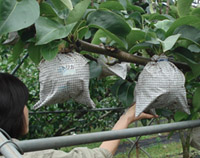sept-30-07 |
||||||
| blogs pics videoschris' page jill's page links contact us home |
|
|||||
We walked around the farm. The farm was not a traditional farm in the same way that a Canadian farm would be laid out in one land parcel. They grew pears and grapes. The two orchards were separated by about 500 metres and the crops grown in between did not belong to them. We first looked around the pear orchard. They grew asian pears, for someone familiar with the North American variety, asian pears are quite different. First of all they are round like an apple, russet in colour and huge! The pear is a meal in itself to be sure. We had seen these pears in the market often, but have only bought them on occasion since one pear costs $2.00 and being my father's son, the inner dialogue begins... "why would anybody pay that As we walked up to the orchard we quickly discovered the answer to our queries at the market. The entire orchard was covered in netting (right) to protect the trees from the birds. As the orchard was the size of a football field this netting was no small undertaking. As we walked closer I tried to make out the shapes of the pears on the branches of the trees but it After the pear orchard we went to the vineyard. It to was covered by white vinyl and netting to protect form sun and birds, and once again the individual bunches of grapes were covered with white bags. It was just shocking to see on the one hand the attention to detail and care taken to individually bag and then all the junk that was strewn around the vineyard. While we realize that things are a little more out of sorts on the farm it was odd to understand how attention to detail when it came to the fruit couldn't be carried over into the care of the farm.
After having lunch at the farm, our hosts were insistent that we take home a large quantity of fruit, which was really nice, and also has been great for Jillan who is often craving the fruit - so it's great to have it in abundance right now. On our way home we took a little detour to check out North Korea.
From first look, of course, North Korea looked no different. The rice fields had a golden hue to them, the mountains were just as high, but when you looked closer through the observation machines you can see the buildings of the nearest town. That's when you Nevertheless it was still quite interesting to see the differences between the two countries, and yet the many similarities. They speak the same language, eat the same food and that's just about where it ends. The lives of the people in both countries are a stark comparison, so that's why it was so interesting to look across the river between the two countries and notice how the land may appear to be the same but the quality of life can be so opposite. After having our look across the river, we headed home, back to Anyang with a car load of fruit and a camera full of pictures. So be sure to check out some of our pictures form the farm and also from the DMZ. |

the view across the Han River shows little difference between the communist and capitalist neighbours
|
|
 seemed like they were white in colour. As we got closer still, we realized that each pear on the branch was covered in a white bag! The bags (left), we were told, cover the pear early in the growth cycle in order to protect them from the scorching summer sun and the bugs - since the birds are already kept out by the netting. All the sudden it quickly became clear why farm houses and the property around them was not kept in pristine condition, they were spending their days bagging pears!
seemed like they were white in colour. As we got closer still, we realized that each pear on the branch was covered in a white bag! The bags (left), we were told, cover the pear early in the growth cycle in order to protect them from the scorching summer sun and the bugs - since the birds are already kept out by the netting. All the sudden it quickly became clear why farm houses and the property around them was not kept in pristine condition, they were spending their days bagging pears! 